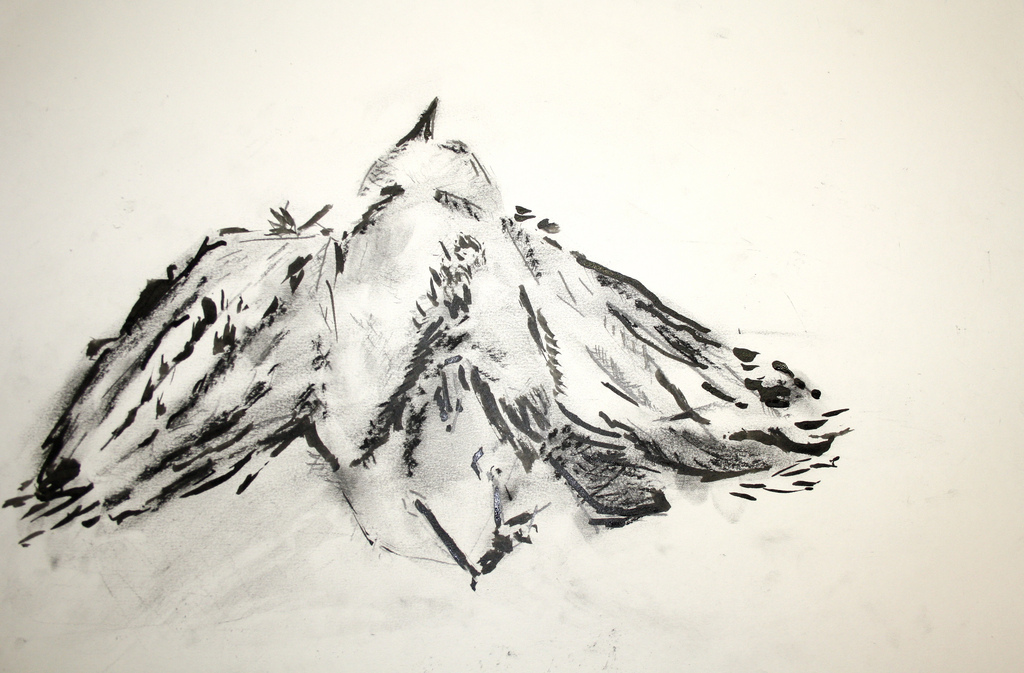Photo by Sophia.
I’ve been having an insightful shuffle through Mihaly Csikszentmihalyi’s book Creativity: The Work and Lives of 91 Eminent People. Mihaly is a seminal professor of Psychology and Management, and is the Founding Co-Director of the Quality of Life Research Center at Claremont. He writes:
“I have devoted 30 years of research to how creative people live and work, to make more understandable the mysterious process by which they come up with new ideas and new things. If I had to express in one word what makes their personalities different from others, it’s complexity. They show tendencies of thought and action that in most people are segregated. They contain contradictory extremes; instead of being an individual, each of them is a multitude.”
Nine out of the ten people in me strongly agree with that statement. As someone paid to be creative, I sometimes feel kaleidoscopic in my views or opinions, and that “multitude” of expressions sometimes confuses those around me. Why does that happen? My thoughts make cohesive sense to me, yet others sometimes feel that I am contradicting myself or switching positions. What is wrong with me?
Mihaly describes 9 contradictory traits that are frequently present in creative people:
01
Most creative people have a great deal of physical energy, but are often quiet and at rest. They can work long hours at great concentration.
02
Most creative people tend to be smart and naive at the same time. “It involves fluency, or the ability to generate a great quantity of ideas; flexibility, or the ability to switch from one perspective to another; and originality in picking unusual associations of ideas. These are the dimensions of thinking that most creativity tests measure, and that most creativity workshops try to enhance.”
03
Most creative people combine both playfulness and productivity, which can sometimes mean both responsibility and irresponsibility. “Despite the carefree air that many creative people affect, most of them work late into the night and persist when less driven individuals would not.” Usually this perseverance occurs at the expense of other responsibilities, or other people.
04
Most creative people alternate fluently between imagination and fantasy, and a rooted sense of reality. In both art and science, movement forward involves a leap of imagination, a leap into a world that is different from our present. Interestingly, this visionary imagination works in conjunction with a hyperawareness of reality. Attention to real details allows a creative person to imagine ways to improve them.
05
Most creative people tend to be both introverted and extroverted. Many people tend toward one extreme or the other, but highly creative people are a balance of both simultaneously.
06
Most creative people are genuinely humble and display a strong sense of pride at the same time.
07
Most creative people are both rebellious and conservative. “It is impossible to be creative without having first internalized an area of culture. So it’s difficult to see how a person can be creative without being both traditional and conservative and at the same time rebellious and iconoclastic.”
08
Most creative people are very passionate about their work, but remain extremely objective about it as well. They are able to admit when something they have made is not very good.
09
Most creative people’s openness and sensitivity exposes them to a large amount of suffering and pain, but joy and life in the midst of that suffering. “Perhaps the most important quality, the one that is most consistently present in all creative individuals, is the ability to enjoy the process of creation for its own sake. Without this trait, poets would give up striving for perfection and would write commercial jingles, economists would work for banks where they would earn at least twice as much as they do at universities, and physicists would stop doing basic research and join industrial laboratories where the conditions are better and the expectations more predictable.”
Sometimes what appears to be a contradiction on the surface is actually a harmony in disguise. My problem has been primarily one of communication. I am learning to let people know what I am thinking and why, and explaining myself in a way that helps them understand why I am discussing multiple perspectives instead of just cleanly stating my own. At first it might not make sense, but give me/us long enough, and it will.


Where is the part that says that true artists almost always have a screw or two loose and usually make the history books only after they are dead?
I see myself in most of the traits listed…
Thank you for your insight. I feel validated.
Hello to all my fellow creatives out there. I found this article very profound as it matches almost exactly the work we do about creatives in my company. Our company teaches organizations how to create mission-perfect teams through intellectual diversity. In our science and language a “creative” is called a Strategist. A Strategist is a person who can give us on-demand creativity. How are they able to do it? It is through an ironic, but very powerful combination of a great strength and a great weakness. The great strength is the Strategists see patterns in life that other people do not see. These patterns lead them to a place “outside the box”….. a creative place. The great weakness is that they are oblivious to protocols….. all forms of protocols. So the proverbial box that we are always talking about,,, it is not as though the Strategist see the box and chose to think outside of it, they don’t even see the box. If you don’t see the box, it is much easier to think outside the box. Of course this “obliviousness” to protocols creates other challenges in life. Strategists have to learn about protocols the hard way. Only 7 to 8% of people are Strategists. A Strategists creativity can exist on any of three different dimensions thinking. Strategists whose creative thinking is centered on the “intuitive” dimension (sensing people and their needs, situations and cultures) will see patterns of talents in people that others do not see. They will see ways to put teams of people together that are very effective and that would not have been considered by others. They will see patterns in the human intellect that others do not see (this is where my creative thinking is centered and this is the business that I am in)). People whose creativity is centered on the “pragmatic” dimension which we also describe as the “now” dimension of thinking will be great creative problem solvers. People whose creativity is centered on the “conceptual” dimension will be very creative in the process of creating systems and plans for the future. The most typical pattern of creativity is to be “Attentive” to creativity on one dimension and to be relatively “inattentive” to creativity on a second dimension. Way less than one percent of human beings are both creative on two dimensions and attentive on both of those dimensions. It is difficult for Strategists to “hang out” with a group of Strategists. We are simply two few for this to happen easily. Since we are the minority in the intellectual world (55% PDs, 25% Networkers, 18% EQs, 7% Strategist), it is difficult to have a community of Strategists. That is why I was so struck by the piece but also by so many of the comments. It is very affirming to know that there are others like us and that we are OK. Unfortunately, the entire education system is “of the PDs, for the PDs and by the PDs who are the 55%”. So, children who are Strategists (as well as Networkers and EQs) do not get the preparation they need for life. Many Strategists kids find themselves thinking at high school graduation: ” I know that I am just as smart as the people going to Harvard and Yale,,, so why am I not going to Harvard or Yale? The answer is that we Strategists and we have a different kind of intelligence. Harvard and Yale and most universities simply don’t know anything about Strategists, and certainly don’t know how to develop our natural strengths.
This article was sent to me by my daughter who is also a Strategist. Her intellect is very similar to mine. She is a world famous professional wood turner. An artist. Most Strategists are strongly motivated to make art as are my daughter and I,,,, but not all. Creativity can exist without the strong motivation to make art. These people will apply their creativity at work. I will be forever grateful to may daughter for sending me this piece.
One more thing (I could write a book on this), in the business world where we do most of our work, half of the Strategist, sadly, are hiding. They are hiding because they have become convinced that their company will just slam their creative ideas. So, unfortunately, they are “hiding” as one of the other intellects, and they are typically moody and prickly when they are doing this. The irony is that these same companies are trumpeting to the heavens that: “we need more innovation”. The average Strategist when asked “how frequently does your company use your natural creativity?” answers “Less than 10%”. All for now. Great job!!!
Thanks for sharing this Marcus, very interesting 😉
Very interesting, my son sometimes struggles in certain areas at school and I find the teacher’s solution is often to squash the traits that I find so intersting and valuable. I am a photographer, but I find that is a true creative soul!
Nice article. Reminds me of….. me!
Thanks for the article, Matthew. I can so identify…I thought I was just weird. Nice to know I have a lot of company. Absolutely love your site and bio. Makes me smile!
I get a little bummed when I read articles about how ‘different’ creative people are, which further leads to the myth and mystification of the creative type. These are qualities that we are all capable of cultivating, among many. I think sometimes this keeps ‘creative’ people detached and in a rut. I don’t think ‘creative’ people often reach their full potential and stay blindly attached to their self-involved stereo-type.